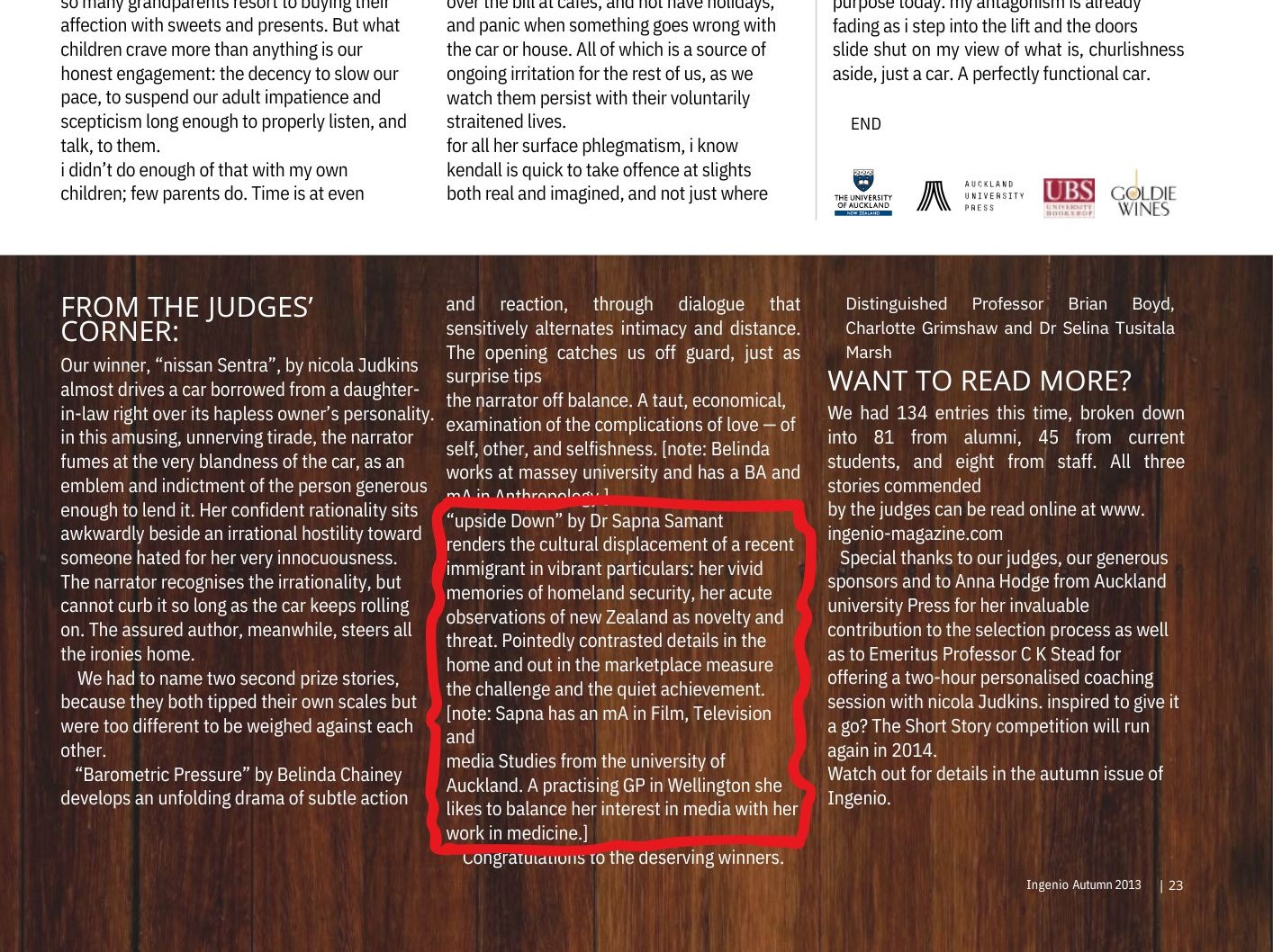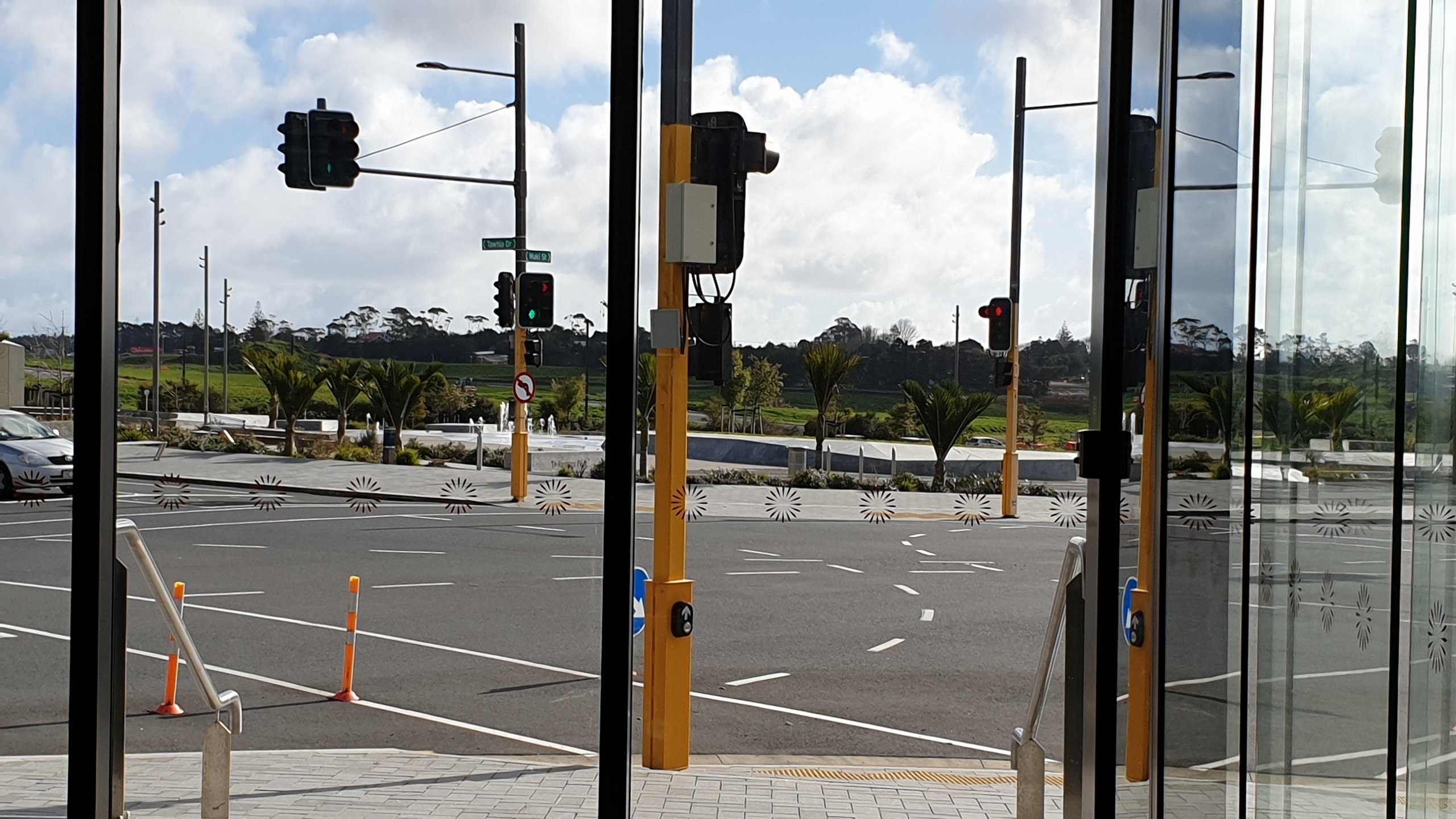Publishing my award winning short story form 2013 here because the original link from Ingenio, the University of Auckland alum magazine no longer exists. This story is from a competition for UoA grads. I won the second prize. Would love to write more short stories. Just need to find the time and space.
Here ⬇️ is the page from the online Ingenio magazine with the judges’ notes. And below that is the story. I have made it bold just to demarcate the content. Enjoy!

UPSIDE DOWN
Pratham sarva samagri ekatra gola karavi.
Gather all the ingredients before you start.
That was the first instruction from her teacher in her first baking class. Sheela had written it in her looping Devanagri script on the five-hundred-page lined notebook with the Murphy baby on the cardboard cover. In Marathi. With a fountain pen and Royal Blue Camlin Ink. The first recipe of her first baking class for upside down pineapple cake. Today it was Edmond’s turn. His Cookery Book called it an Upside Down Pudding and he did not explicitly direct you to collect the ingredients right at the beginning. Maybe he just expected it? Maybe that is how they taught cooking in New Zealand? Assuming that all cooks gathered the ingredients before they started? The instructions from her first teacher were ingrained in Sheela’s brain. She was a stylish lady, the teacher; in her silk saree, bobcut hair and peach lipstick, softly but firmly coaching the students in her nasal Marathi. The teacher’s husband was an executive at a Tata company and she travelled with him to London once a year. By aeroplane.
It was a seventeen hour flight from Mumbai to Auckland, Sheela’s first trip in an aeroplane ever. And the first time she had spoken to foreigners. White people in uniform, Chinese people who spoke with an Australian accent and the red haired, bearded boy in a kurta and harem pants. Namaste, he had smiled. Sheela had not known how to react. The only white people she had seen were on television and on the streets of Colaba. What does one say to white people who actually greet you in a transit lounge where you are suddenly, visibly Indian? Sheela had taken a deep breath and smiled back, forgetting everything she had rehearsed in front of the mirror; hello, how are you, thank you, good bye.
Then she was lost again. Invisible in the lonely streets of Grey Lynn. She did not know what to do with herself during the day. Her daughter had bought her the bus pass and shown her how to read a map. Take a ride, go into town, walk along the waterfront. Stop thinking for a change. Sheela got the hang of it, slowly. Hello and thank you to the bus driver, smile at others and wait for the red man to turn green before you crossed the road. No need to dodge cars. There was all the time in the world and not enough people.
Sheela spotted that posh shop on Ponsonby Road from the bus. Beautifully arranged, colour co-ordinated cookware and containers inviting her to consume. She scrutinised the shop window until she zeroed in on the baking tray. It was black and shiny.
Hello, I would like to buy this baking tray. She’d practised for hours. In her head; under her breath; sometimes in front of a mirror when no one was looking. How to sound Kiwi in her first proper conversation with a white person.
‘Aaji talks to herself’, Rani told her parents. ‘She keeps saying hello.’
‘Aaji must be practicing how to speak New Zealand’, Leena informed her little daughter.
‘Can I help you?’ a skinny girl with a white face and orange skin on the rest of her body asked her loudly when Sheela boldly stepped into the shop. Fake bold. She faltered at the greeting.
‘Hello.’ The accent was embedded in her tongue. No amount of practice was going to get rid of it.
The girl nodded down to her.
Why do some of these gora ladies have orange skin, Sheela had asked her daughter. That is a tan, Leena informed her. A tan? Doesn’t a tan make our skin dark brown, black? Do white people become orange? Because it is from a lotion or a spray. Accha, accha. Strange are the ways of the white people.
‘I want that baking tray’, Sheela pointed it out to the girl with the white face and imitation tan. The girl had followed her through the shop, stopping every time Sheela paused.
‘Sure. Would you like anything else?’ Now she had a fake smile.
Her first baking tray, an aluminium tray, Sheela had bought at a little shop inside the Crawford Market, after Arthur Crawford, the first Municipal Commisioner of Bombay. Later renamed Mahatma Jyotiba Phule Mandai, after the social reformist, long before Bombay became Mumbai. So long ago no one remembered who he was and what he had done. Sheela knew. The reason why she and her sister and other girls were able to go to school; why she was able to educate her daughter. Because of Jyotiba. Now vanished in the haze of the pollution around Crawford Market.
‘What size you want aunty?’ Abdul had asked, noticing her standing tentatively by the crowd of Parsi and Catholic cake baking women.
‘Son, go get a medium size tray for aunty. It is on the third shelf from the left’ Abdul yelled at a scruffy boy who scurried off into a man size rat hole inside the shop. She had purchased all her baking utensils from Abdul until the Guardians Of Hinduism razed the shops owned by Muslims inside the Mahatma Jyotiba Phule Mandai one oppressive January. It was Abdul who had directed her to a man who gave Sheela a discount on an oven.
‘You are learning to bake?’ her sister-in-law had asked incredulously when she saw the oven while visiting her mother from another city. ‘In our family we feed our men only Indian food and you still don’t know how to roll out the perfect chappati! My mother’s kitchen has no place for an oven.’
Gentle breeze flowed through the French windows opening out on the wooden deck. The sun shone bright and white. In New Zealand the ovens are built into the stove and Sheela had muffin shaped mitts her granddaughter chose for her. Now to test whether the Upside Down Pudding from Edmond’s Cookery Book was as good as her teacher’s recipe.
The oven beeped. It was 2.45 in the afternoon. Sheela took off her apron. Rani would be waiting for her aaji to pick her at school. They would come back home and watch another episode of Sesame Street on the computer while the cake rested before Sheela unmoulded it.

















